Difference between revisions of "Artificial leather with leather fibres on the reverse"
m |
|||
| Line 5: | Line 5: | ||
== Leather fibres on the reverse of [[imitation leather]] == | == Leather fibres on the reverse of [[imitation leather]] == | ||
| − | In the [[leather furniture|furniture sector]] | + | In the [[leather furniture|furniture sector]] [[imitation leather|synthetic leather]] with leather fibres glued to the reverse is a commonly used material. In other words, the main components are other materials and the use of leather is restricted to the [[Bonded leather|leather fibres]] that are glued on the back. |
| Line 16: | Line 16: | ||
<p> </p> | <p> </p> | ||
| − | In advertisements, these materials are | + | In advertisements, these materials are promoted as "leather-like" or linked as closely as possible to the term "leather". Any suggestion that this material is [[genuine leather]] is both false and misleading. It is also referred to as "sustainable" and "[[Bonded leather#Recycled leather|recycled leather]]". In such cases, customers are advised to seek clarification. |
| − | + | This material has no advantages over "normal" [[imitation leather|artificial leather]]. Just because leather fibres are glued to the back, does not mean this material can now offer any of the benefits of leather. The fibres do not have their own stability, do not absorb moisture and, at the very least, have a minimal effect on the material. | |
| − | Leather fibres are a waste product of | + | Leather fibres are a waste product of [[leather production]] and often end up in waste incinerators. Since this method of back-bonding is emphasised in advertising, it must be assumed that it is an attempt to suggest a "natural" feature of an artificial product. Manufacturers of these materials have been asked to explain whether there were practical reasons for glueing leather fibres on the reverse or if it was just a marketing ploy. So far there has been no answer. |
| Line 33: | Line 33: | ||
</p> | </p> | ||
<p align=center> | <p align=center> | ||
| − | ''An extreme example | + | ''An extreme example of an [[leather#What materials can be called leather?|incorrect declaration]]''<br></p> |
<p> </p> | <p> </p> | ||
| − | There are also imitation leathers where it is not clear | + | There are also imitation leathers where it is not clear if leather fibres have been glued on the reverse or whether it is a thin [[suede|split leather layer]] that has been glued. But the latter also cannot be called [[genuine leather|"leather" or "genuine leather"]]. If the layer on a leather is stronger than 1/3 of the total thickness, the material as a whole can no longer be called [[genuine leather|leather]]. |
| Line 57: | Line 57: | ||
</p> | </p> | ||
<p align=center> | <p align=center> | ||
| − | ''An artificial leather with leather fibres on the back, without any benefit to the customer | + | ''An artificial leather with leather fibres on the back, without any benefit to the customer, sustainability or ecology.''<br></p> |
<p> </p> | <p> </p> | ||
== Damage to synthetic leather with leather fibres on the reverse == | == Damage to synthetic leather with leather fibres on the reverse == | ||
| − | In contrast to [[genuine leather]], the life time of | + | In contrast to [[genuine leather]], the life time of [[imitation leather]] furniture is often much shorter than expected as the materials soon breaks under daily wear and tear. |
| Line 73: | Line 73: | ||
</p> | </p> | ||
<p align=center> | <p align=center> | ||
| − | ''An extreme example | + | ''An extreme example of an [[leather#What materials can be called leather?|incorrect declaration]] and the associated wear and tear.''<br></p> |
<p> </p> | <p> </p> | ||
Revision as of 18:27, 24 March 2017
Contents
Leather fibres on the reverse of imitation leather
In the furniture sector synthetic leather with leather fibres glued to the reverse is a commonly used material. In other words, the main components are other materials and the use of leather is restricted to the leather fibres that are glued on the back.
Imitation leather with reverse glued leather fibres.
In advertisements, these materials are promoted as "leather-like" or linked as closely as possible to the term "leather". Any suggestion that this material is genuine leather is both false and misleading. It is also referred to as "sustainable" and "recycled leather". In such cases, customers are advised to seek clarification.
This material has no advantages over "normal" artificial leather. Just because leather fibres are glued to the back, does not mean this material can now offer any of the benefits of leather. The fibres do not have their own stability, do not absorb moisture and, at the very least, have a minimal effect on the material.
Leather fibres are a waste product of leather production and often end up in waste incinerators. Since this method of back-bonding is emphasised in advertising, it must be assumed that it is an attempt to suggest a "natural" feature of an artificial product. Manufacturers of these materials have been asked to explain whether there were practical reasons for glueing leather fibres on the reverse or if it was just a marketing ploy. So far there has been no answer.
An extreme example of an incorrect declaration
There are also imitation leathers where it is not clear if leather fibres have been glued on the reverse or whether it is a thin split leather layer that has been glued. But the latter also cannot be called "leather" or "genuine leather". If the layer on a leather is stronger than 1/3 of the total thickness, the material as a whole can no longer be called leather.
Suede or leather fibres on the reverse? In any case, it`s not "leather" as per standards and consumers.
An artificial leather with leather fibres on the back, without any benefit to the customer, sustainability or ecology.
Damage to synthetic leather with leather fibres on the reverse
In contrast to genuine leather, the life time of imitation leather furniture is often much shorter than expected as the materials soon breaks under daily wear and tear.
An extreme example of an incorrect declaration and the associated wear and tear.
There are also complaints about these types of leather in other countries. In Australia, a furniture store has sued the furniture supplier for 1,000 complaints in just one year (2013). The surface coating of artificial leather with leather fibres on the back pelted off after one to two years. Many customers bought furniture with a 5-year warranty, which didn`t cover brittle damages and cracks.
Delamination after almost two years, not covered by a 5-year warranty.
Leather mobile phone case with leather fibres on the reverse
Synthetic leather with leather fibres glued to the reverse is also processed on mobile phone cases.
The stability comes from the upper, foamed and coated layer. The leather fibres are glued to the reverse and have no benefit.
Additional information
- PU leather
- Buffalo split leather
- Napalon leather
- Madras leather - Madras imitation leather
- Mobile phone cases







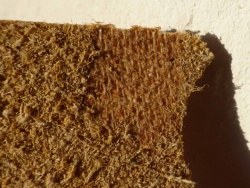
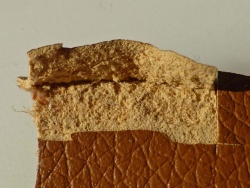
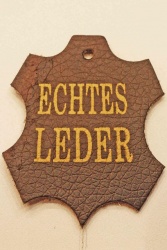
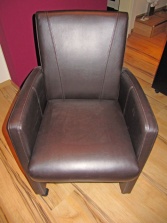
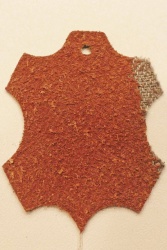
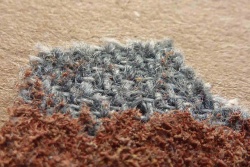
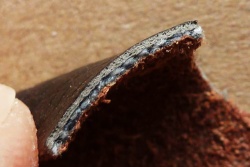
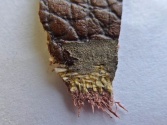
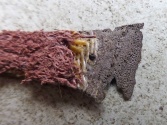
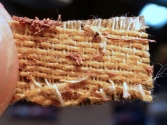
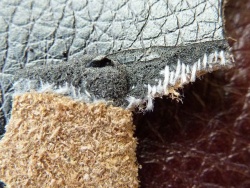
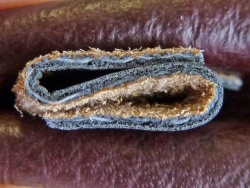
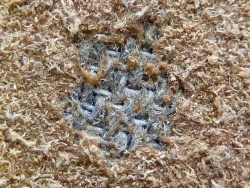
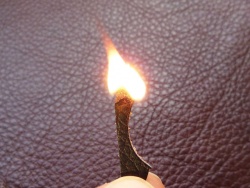
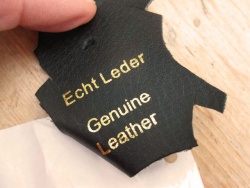
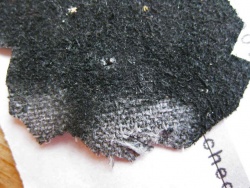
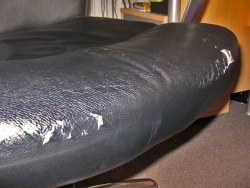
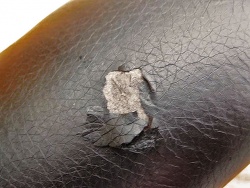

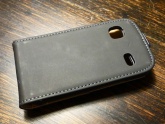
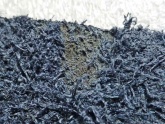
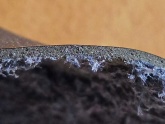

 a kotori web solution
a kotori web solution